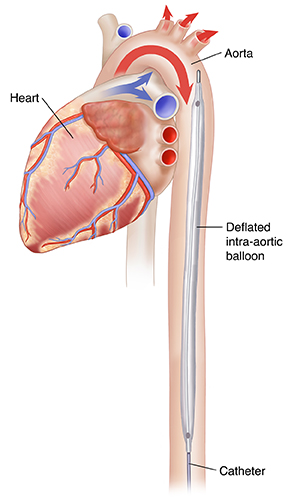Understanding Intra-Aortic Balloon Pump Therapy
An intra-aortic balloon pump (IABP) is a device that helps your heart pump more blood. This treatment is often used if you are very ill and your heart is failing.
The IABP has several parts. One part is a thin, flexible tube called a catheter. The catheter is put in a large artery in your groin. Attached to the tip of the catheter is a long balloon. The balloon is inserted into your aorta. The aorta is the very large artery leaving your heart. The balloon is called an intra-aortic balloon, or IAB. The other end of the catheter is outside your body. It attaches to a computer and a pump. The computer tells the balloon to inflate and deflate at the right time when your heart beats.
From there, the IABP can start to do its work. The balloon is set to inflate when the heart relaxes. It pushes blood flow back toward the coronary arteries. They may not have been getting enough blood without the pump. When the heart contracts, the balloon deflates. That allows the heart to pump more blood out to the body while using less energy. The device continues to inflate and deflate until it's removed.


Why intra-aortic balloon pump therapy is done
IABP therapy is a short-term treatment. It's mostly used to treat cardiogenic shock. That’s when your heart can’t pump enough blood to meet the needs of your body. Some heart problems can cause cardiogenic shock. These include:
You may also need an IABP if you have a certain medical procedure. For example, you may need it if you have a percutaneous coronary intervention. This procedure opens a blocked artery in the heart. You also might benefit from an IABP if you have or are going to have heart surgery such as coronary artery bypass grafting (CABG).
Your healthcare provider can adjust the IABP device to help you with every heartbeat, every other heartbeat, or even every third or fourth heartbeat. They can increase or decrease the amount of help the device gives you based on how well your heart is recovering from the cardiogenic shock.
If your heart is unable to recover, you may need therapy that is even more advanced than an IABP. You may need a heart transplant. Or you may need a long-term heart assist device. This might be a left ventricular assist device (LVAD). An LVAD is a pump that is implanted by surgery.
How intra-aortic balloon pump therapy is done
IABP therapy may be done during another type of heart surgery. In an emergency, a medical team may insert it at your bedside. Or a healthcare provider may insert it before or during a heart artery procedure. These include cardiac catheterization and coronary angiography.
Risks of intra-aortic balloon pump therapy
IABP therapy can be very helpful. It can sometimes even be lifesaving. But it does have some risks. These include:
-
Damage from the lack of blood flow to a limb (ischemia). This can happen if the tubing and pump block blood flow through the artery they are inserted into.
-
Injury to the artery the pump is inserted into
-
Rupture of the balloon
-
Incorrect position of the balloon. This might cause injury to the kidneys or other problems.
-
Low platelet count. The platelets can be harmed by the force of the balloon inflating and deflating inside the blood vessel. This might cause extra bleeding because your blood doesn’t clot as well.
-
Infection
-
Stroke can happen if plaque along the artery wall is knocked free by the pump. Clots can also form along the tubing inside the blood vessel. These can break free and travel to the brain and other arteries in the body.
Your risks depend on your age and your overall health. For example, a lack of blood flow to your leg may be more likely if you have peripheral vascular disease. Talk with your healthcare provider about which risks apply most to you. Also talk with your provider about any concerns you have. Your family or the person designated to make healthcare decisions for you may need to talk with your provider if you are too ill to speak with them.